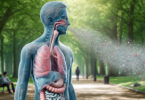By John Patterson
Staff Writer for Wake Up World
Amid our bustling lives, an invisible threat lurks, claiming over one million lives globally every year. The culprit? Short-term exposure to fine particulate matter (PM2.5) in air pollution. A groundbreaking report reveals that, particularly in Eastern Asia, this silent killer is responsible for more than half of the deaths attributable to short-term PM2.5 exposure worldwide.
Understanding the Impact of PM2.5
PM2.5 refers to fine particulate matter that is 2.5 micrometers or smaller in diameter. These particles, invisible to the naked eye, can penetrate the respiratory system, causing many health issues, including premature death. Traditionally, studies have concentrated on the health implications of living in areas with consistently high pollution levels. However, a recent study by Monash University sheds light on the deadly effects of intermittent, yet intense, pollution spikes.
The Global Study That Changes Everything
Led by Professor Yuming Guo, the research analyzed mortality and pollution levels in over 13,000 cities and towns worldwide from 1999 to 2019. Published in The Lancet Planetary Health, this study stands out as the first to assess the global implications of short-term exposure to PM2.5. “The short-term health effects of being exposed to air pollution have been well documented,” says Professor Guo. He recalls the devastating mega fires in Australia during the Black Summer of 2019-20, which resulted in numerous smoke-related premature deaths and hospital admissions.
The Stark Findings
The study found that even brief exposure to PM2.5, ranging from a few hours to several days, leads to over a million premature deaths each year, particularly in Asia and Africa. A significant 22.74% of these deaths occur in urban areas, underscoring the heightened risk in cities due to their dense populations and elevated pollution levels.
A Closer Look at the Numbers
- Asia accounts for approximately 65.2% of global mortality due to short-term PM2.5 exposure.
- Africa follows with 17.0%, Europe with 12.1%, the Americas with 5.6%, and Oceania with a mere 0.1%.
- The highest mortality burden is observed in eastern Asia, southern Asia, and western Africa, where the fraction of deaths attributable to short-term PM2.5 exposure significantly exceeds the global average.
Interestingly, while most regions in Australia witnessed a decrease in the number of attributable deaths, the fraction of deaths increased from 0.54% in 2000 to 0.76% in 2019. This trend highlights the growing threat of extreme weather-related air pollution events, such as bushfires.
Mitigating the Acute Health Damages
The study emphasizes the importance of targeted interventions in regions where health is severely impacted by acute air pollution. Implementing air-pollution warning systems and community evacuation plans can play a crucial role in preventing transient exposure to high concentrations of PM2.5, thereby mitigating its acute health damages.
Empowering Yourself Against Air Pollution: Practical Tips for Everyday Life
As we digest the sobering realities presented by the latest research on short-term air pollution exposure, it’s crucial to remember that we’re not powerless. There are actionable steps each of us can take to reduce our exposure to dangerous PM2.5 particles and protect our health. Here are some practical tips you can implement in your daily life to breathe easier:
1. Stay Informed About Air Quality
- Use Air Quality Index (AQI) Apps: Download an app or visit websites that provide real-time air quality information. Monitoring your area’s AQI can help you plan outdoor activities when the air is cleaner and stay indoors during pollution spikes.
2. Create a Clean Air Sanctuary at Home
- Invest in Air Purifiers: Equip your home, especially bedrooms, with air purifiers that have HEPA filters to remove fine particulate matter from indoor air.
- Maintain Indoor Plants: Certain plants can absorb pollutants. Snake plants, spider plants, and peace lilies are known for their air-purifying properties.
- Seal Windows During High-Pollution Days: Keep windows and doors closed during high-pollution episodes to prevent outdoor pollutants from entering.
3. Protect Yourself Outdoors
- Time Your Activities: Engage in outdoor activities during times when pollution levels are lower, usually early in the morning or later in the evening.
4. Reduce Your Own Pollution Footprint
- Use Public Transportation, Bike, or Walk: Whenever possible, opt for transportation options that produce less pollution.
5. Plan for Pollution Peaks
- Prepare for Sensitive Groups: If you or someone in your family is part of a sensitive group (children, elderly, or those with respiratory conditions), have a plan for days with high pollution levels, including access to medications and indoor activities.
By adopting these measures, you not only safeguard your own health but also contribute to a larger movement towards a cleaner, healthier environment. Let’s take these steps together towards a future where the air we breathe doesn’t pose a hidden threat to our well-being.
As we navigate through the complexities of modern life, we must address the silent threat of short-term air pollution. Through awareness, research, and targeted action, we can safeguard our communities from the lethal grip of PM2.5 and pave the way for a healthier future. Let this study serve as a wake-up call, prompting us to take collective action against the invisible dangers that threaten our well-being.
Journal Reference:
- Estimates of global mortality burden associated with short-term exposure to fine particulate matter (PM2·5). The Lancet Planetary Health, 2024; 8 (3): e146 DOI: 10.1016/S2542-5196(24)00003-2
About the author:
John Patterson is an avid writer and researcher who delves into the latest scientific research. With an insatiable curiosity, he translates complex concepts into accessible narratives, allowing readers to embark on a journey of discovery. John bridges the gap between experts and the public through his work, igniting curiosity and inspiring meaningful conversations about scientific breakthroughs.

If you've found value in our articles, we invite you to support the release of our brand-new book, "Gratitude Practices for Kids: A Practical Guide for Adults to Instill a Spirit of Appreciation and Positivity in the Next Generation."
"Gratitude Practices for Kids" brings together over 25 innovative and accessible practices designed to enhance gratitude in everyday life. This comprehensive guide is backed by 17 scientific studies, ensuring each concept is grounded in research, underscoring our commitment to nurturing growth, emotional intelligence, and positive interactions between adults and children.
We encourage you to opt for the paperback version to celebrate this new release. Dive into its fresh pages away from digital distractions, allowing you to immerse yourself in the transformative practices it offers.
Over recent years, Wake Up World has faced significant online censorship, which has impacted our financial ability to operate. Moving into book publishing represents a strategic step to secure the ongoing funds needed to continue our mission. By purchasing Gratitude for Kids, you help us keep our content free and accessible to everyone, avoiding needing a paywall. With over 8,500 articles published in the last 13 years, we remain dedicated to keeping our valuable content open to all.







